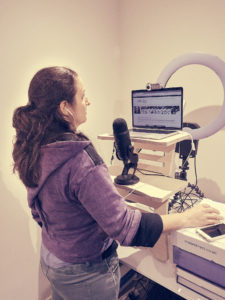Authors are often challenged by the sedentary nature of our work. Dr. Brent Wells offers four questions to consider when you’re wanting to make sure you take good care of your body.
 Writers spend an inordinate amount of time sitting at their desks, typing away on their latest masterpiece. For those of you who use scheduling to boost your productivity, you already know how many hours you spend working at your craft. You hardly ever move from your sedentary position when the words are flowing. What could this mean for your long-term health?
Writers spend an inordinate amount of time sitting at their desks, typing away on their latest masterpiece. For those of you who use scheduling to boost your productivity, you already know how many hours you spend working at your craft. You hardly ever move from your sedentary position when the words are flowing. What could this mean for your long-term health?
A sedentary lifestyle takes a serious toll on your body and lifespan. Research is consistently showing that our creative lifestyle has far-reaching consequences that we need to address immediately.
Let’s take a closer look at how writing affects your health and what you can do to correct it.
What’s Your Chair Like?
Think about the surface that you sit on during the day. Is it hard and unforgiving or do you settle right into its plush surface? Very few writers have chairs that offer support for their lower backs and spines. Sitting on a hard surface increases the amount of compression in your spine from the lower back all the way up to your neck.
This compression has an unexpected side effect: it can actually reduce your height. According to a study cited in the Iowa Orthopaedic Journal, spine height is decreased with extended periods of sitting. You may be able to regain your height through hyperextension, but it would be best to prevent this from happening in the first place.
 The ideal way to combat spine compression is to make your chair more comfortable. Purchasing a seating pad to go on your existing chair is the least expensive route. However, you may want to invest in an entirely new chair that offers more support for your spine and tailbone. You’ll feel more comfortable and your spine will ultimately thank you.
The ideal way to combat spine compression is to make your chair more comfortable. Purchasing a seating pad to go on your existing chair is the least expensive route. However, you may want to invest in an entirely new chair that offers more support for your spine and tailbone. You’ll feel more comfortable and your spine will ultimately thank you.
How Often Do You Stand Up?
Sitting for extended periods of time can wreak havoc on your body. Most writers could spend hours sitting in front of their computers once they hit their stride. Unfortunately, experts advise that we should be getting up and moving around every twenty minutes.
Research is now indicating that you should stand for at least two minutes after twenty minutes of desk-bound work.
Standing or walking around your office for this brief period of time has a lot of benefits:
- Takes some of the pressure off your spine
- Reduces the risk of diabetes
- Reduces the risk of heart disease
- Weight loss
- Improved brain function
To achieve this goal, consider standing up every time you finish a page or two. Return to your kitchen to heat up another cup of coffee. Purchase a desk that allows you to stand up and type.
When your creativity flows, stand up and write down what occurs to you during brainstorming. There are so many ways to work more physical activity into your workday.
Where is Your Computer Screen?
Do you feel a lot of tension in the back of the neck and the shoulders? You may be suffering from what experts call “tech neck.” This common condition is caused by looking down at your screen for extended periods of time each day.
During your periods of inactivity, most people unconsciously contract the muscles in their neck and shoulders. The tension causes their heads to lean forward and puts more pressure on the muscles of the neck.
One study demonstrated that this forward head posture can result in chronic neck pain. It also reduces your respiratory muscles and impacts the function of this critical body system. Fortunately, this can be corrected by adjusting your posture.
Changing your posture during your working hours is relatively simple. All you need to do is make a handful of changes to your workspace:
- Move your computer screen up to eye level so you don’t have to look down
- When checking emails on your smartphone, keep the phone up closer to your eye level
- Sit in a chair with a headrest (and actually use it!)
- Stretch your neck and upper back muscles often
- Stay hydrated
Are You Sitting Up Straight?
You were likely admonished to sit up straight your entire life. Despite many reminders to correct your posture, it is still tempting to settle into a slouched position at your desk. It is far easier to focus on your writing than on your spine. Sliding further down in your chair and rounding your back has a serious impact on your overall health.
 In a relatively recent study, researchers took a look at posture habits while using the computer to see if there was a correlation between slumping and low back pain. They discovered that there is a high prevalence of low back pain when posture is sacrificed.
In a relatively recent study, researchers took a look at posture habits while using the computer to see if there was a correlation between slumping and low back pain. They discovered that there is a high prevalence of low back pain when posture is sacrificed.
In order to get rid your lower back pain for good, you really need to correct your posture. Sit up nice and tall in your chair with your shoulders proudly rolled back. Let your head rest on the headrest of your chair.
Allow your core muscles to help support you while you sit. You could even place a small pillow behind your low back for more support. All of these actions work together to reduce the pressure on your spine and improve your overall health.
Improve Your Health Today
Prevention is the key to addressing many of the chief complaints that writers have about their health. Sometimes, the damage is already done and you may need professional help to resolve your pain.
Consider enlisting the help of a chiropractor to help with a spinal adjustment. This can be a great way to kickstart change in your life and offer you some immediate relief.
Writing can take a serious toll on your body, so be sure to pay attention to the signals your body is giving you. With just a few simple actions, you can improve your overall wellbeing and reduce your pain. You can spend more time focusing on your latest project and less time stressing over those aches and pains.
What measures do you take to ensure you’re a healthy writer? Please leave your thoughts below and join the conversation.
 Dr. Brent Wells is a graduate of the University of Nevada where he earned his bachelor’s of science degree before moving on to complete his doctorate from Western States Chiropractic College. Currently a chiropractor in Alaska, he founded Better Health Chiropractor Wasilla AK.
Dr. Brent Wells is a graduate of the University of Nevada where he earned his bachelor’s of science degree before moving on to complete his doctorate from Western States Chiropractic College. Currently a chiropractor in Alaska, he founded Better Health Chiropractor Wasilla AK.
He became passionate about being in the chiropractic field after his own experiences with hurried, unprofessional healthcare providers. The goal for Dr. Wells is to treat his patients with care and compassion while providing them with a better quality of life through his professional treatment.
Dr. Wells is a member of the American Chiropractic Association and the American Academy of Spine Physicians. He continues his education to remain active and updated in all studies related to neurology, physical rehab, biomechanics, spine conditions, brain injury trauma, and more.

